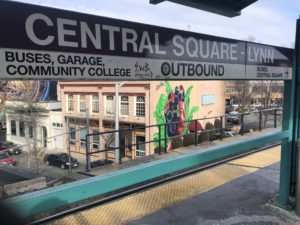
Development-friendly zoning, transit connections to North Station’s growing job cluster and Lynn’s rising public art profile laid the groundwork for one of the city’s largest developments since the Industrial Revolution. Photo by Steve Adams | Banker & Tradesman staff
As policymakers eye ways to get more people on public transit to ease traffic, a new study says many potential riders can’t afford to get on board the state’s 400-mile commuter rail network.
The MassINC report, by Elizabeth Haney, Tracy Corley and Ben Forman, urges policymakers to make a more equitable commuter rail fare framework “priority number one,” describing a shift away from strict distance-based fares as vital to ensuring that future development in Gateway Cities, mostly located far from Boston, produces equitable outcomes and does not displace low-income households.
In many Massachusetts cities, low-income riders are effectively priced out of using commuter rail, unable to afford, for instance, the $12.25 fare for a one-way ride to Boston from Worcester. The $4,600 per year expense associated with that fare is 10 percent of the median household income in Worcester.
Juana Matias, a former state representative who is now MassINC’s chief operating officer, said her neighbors in Lawrence can’t afford to take the train daily to Boston “because we’ve set the fares well beyond their means.”
And the report notes that two-thirds of households near the commuter rail station in Lynn are low-income, but that they represent only 7 percent of riders who board the train in that city. Those residents could be displaced, the report said, as new market rate housing attracts people who can afford commuter rail costs, which are currently $7 for a one-way trip to Boston from Lynn.
The MBTA sets fares for the commuter rail system, which is operated by Keolis under a contract with the transit authority.
Researchers said fare discounts implemented by U.S. transit agencies have been limited to bus and subway systems.
“The MBTA could establish new standards for equitable mobility and, in the process, become the first to make commuter rail travel affordable for all,” the report said. “The argument for proceeding ahead of others is strong given the system’s extensive reach to older industrial cities that have been disconnected from economic opportunity for far too long, and the Baker Administration’s stated policy objective of siting more affordable housing near Gateway City rail stations.”
Specifically, the 14-page report urges the state to consider experimenting with means-tested fares, lowering fares for reverse commuters, reducing fares for off-peak travel and developing a standard definition of transportation equity and applying it consistently to all planning and policy studies.
A multi-directional regional rail system that supports more geographically balanced economic development in eastern Massachusetts may be years off, but the report suggests the technology exists now to discount commuter rail fares for low and moderate-income riders “with minimal transaction cost.”
“The commuter rail system may be able to absorb this ridership by adding coaches to current trainsets rather than adding more service,” the report said. “If this is the case, these additional passengers would likely produce net new operating revenue” for the MBTA.
The report pegs the annual cost of commuting to Boston from more affluent suburbs closer to the city at less than 2 percent of median household income, and estimates that 80 percent of households in gateway cities with current or planned commuter rail service have access to at least one car, with annual vehicle costs running about $12,000 per year.




 |
| 

